9.点赞/收藏功能
本系列文章为
laracasts.com的系列视频教程——Testing Laravel 的学习笔记。若喜欢该系列视频,可去该网站订阅后下载该系列视频,支持正版。
本节说明
- 对应第 9 小节:Liking A Model With TDD
本节内容
在一个 Laravel 应用中,对一个模型进行点赞或者是收藏是很常见的功能,例如我们可以点赞某个评论,收藏某篇文章。本节我们就来学习如何用 TDD 来开发这一功能。首先我们来对评论进行点赞,我们需要建立Post模型:
php artisan make:model Post -m修改迁移文件:
database/migrations/{timestamp}_create_posts_table.php
<?php
use Illuminate\Support\Facades\Schema;
use Illuminate\Database\Schema\Blueprint;
use Illuminate\Database\Migrations\Migration;
class CreatePostsTable extends Migration
{
/**
* Run the migrations.
*
* @return void
*/
public function up()
{
Schema::create('posts', function (Blueprint $table) {
$table->increments('id');
$table->unsignedInteger('user_id');
$table->string('title');
$table->text('body');
$table->timestamps();
});
}
/**
* Reverse the migrations.
*
* @return void
*/
public function down()
{
Schema::dropIfExists('posts');
}
}然后我们来编写我们的第一个测试的思路:
tests/Unit/it/LikesTest.php
<?php
namespace Tests\Unit;
use Tests\TestCase;
use Illuminate\Foundation\Testing\RefreshDatabase;
class LikesTest extends TestCase
{
use RefreshDatabase;
/** @test */
public function a_user_can_like_a_post()
{
// given we have a post
// and a logged user
// when the user like a post
// then we should see evidence in the database, and the post should be liked
}
}
我们按照思路来填充代码:
.
.
/** @test */
public function a_user_can_like_a_post()
{
// given we have a post
$post = factory('App\Post')->create();
// and a logged user
$user = factory('App\User')->create();
$this->actingAs($user);
// when the user like a post
$post->like();
// then we should see evidence in the database, and the post should be liked
$this->assertDatabaseHas('likes',[
'user_id' => $user->id,
'likeable_id' => $post->id,
'likeable_type' => get_class($post),
]);
}然后运行测试: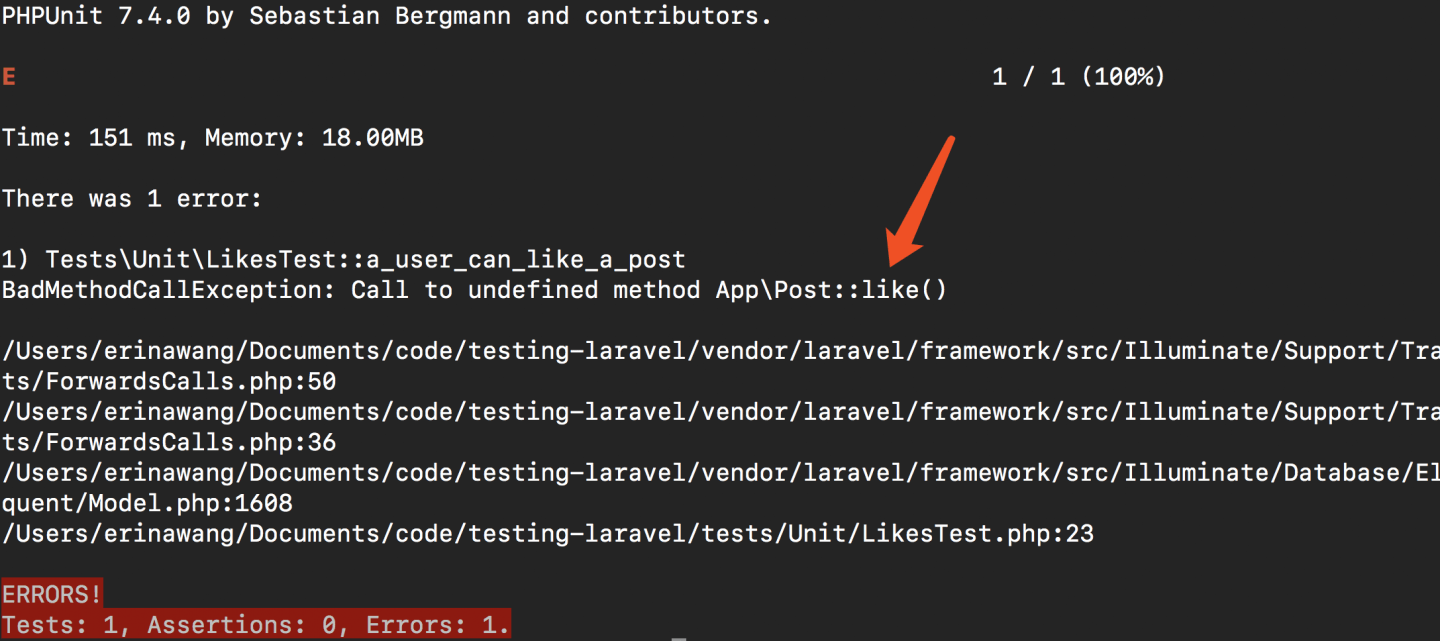
添加like()方法:
app/Post.php
<?php
namespace App;
use Illuminate\Database\Eloquent\Model;
class Post extends Model
{
public function like()
{
}
}再次测试: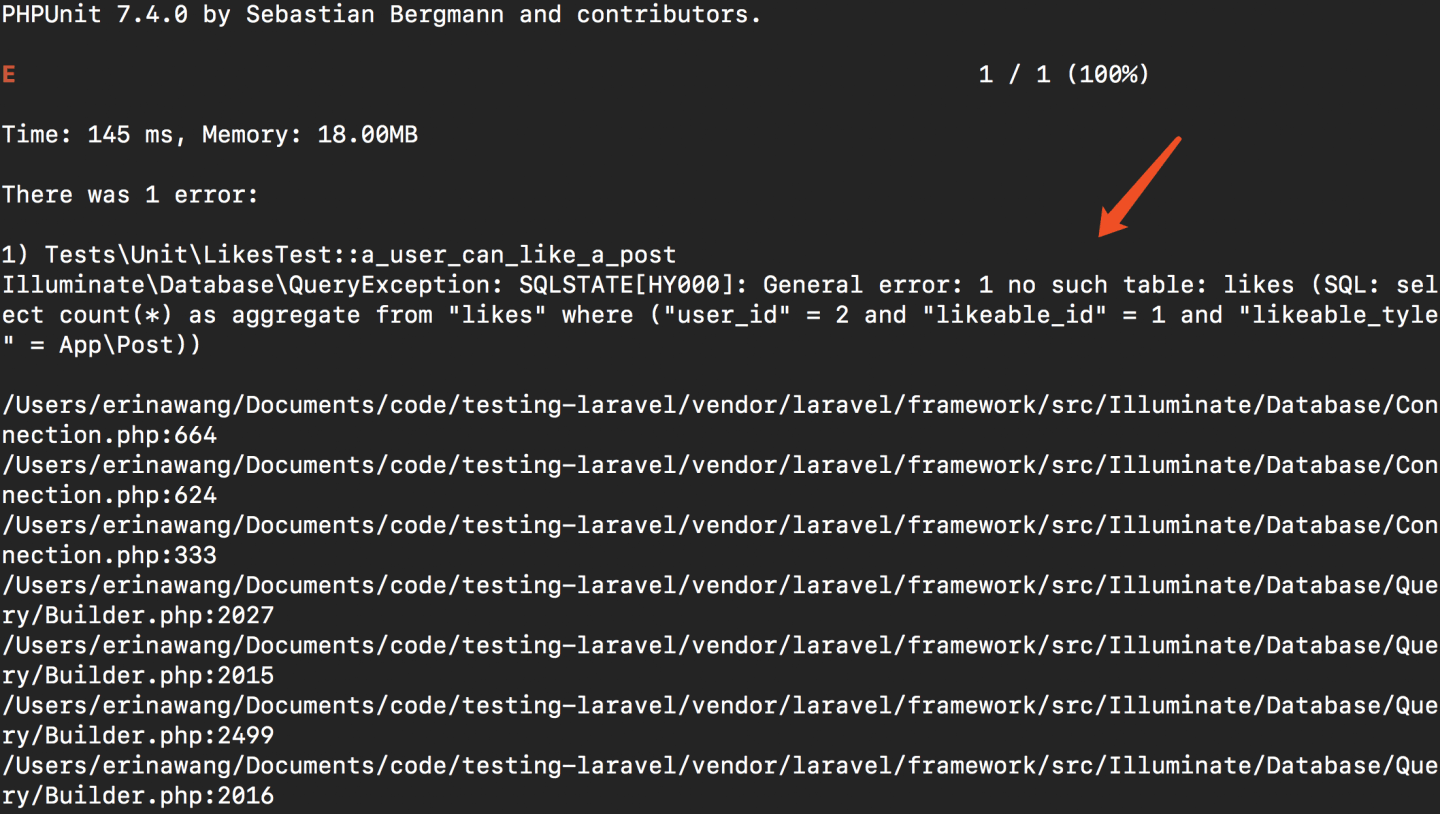
在我们的设定中,点赞这一行为不仅可以发生评论模型中,还可以发生在其他模型上,所以它与其他模型是 多态关联 的。所以我们新建Like模型并修改迁移文件如下:
database\migrations{timestamp}_create_likes_table.php
<?php
use Illuminate\Support\Facades\Schema;
use Illuminate\Database\Schema\Blueprint;
use Illuminate\Database\Migrations\Migration;
class CreateLikesTable extends Migration
{
/**
* Run the migrations.
*
* @return void
*/
public function up()
{
Schema::create('likes', function (Blueprint $table) {
$table->integer('user_id')->index();
$table->unsignedInteger('likeable_id');
$table->string('likeable_type');
$table->primary(['user_id','likeable_id','likeable_type']);
$table->timestamps();
});
}
/**
* Reverse the migrations.
*
* @return void
*/
public function down()
{
Schema::dropIfExists('likes');
}
}再次运行测试: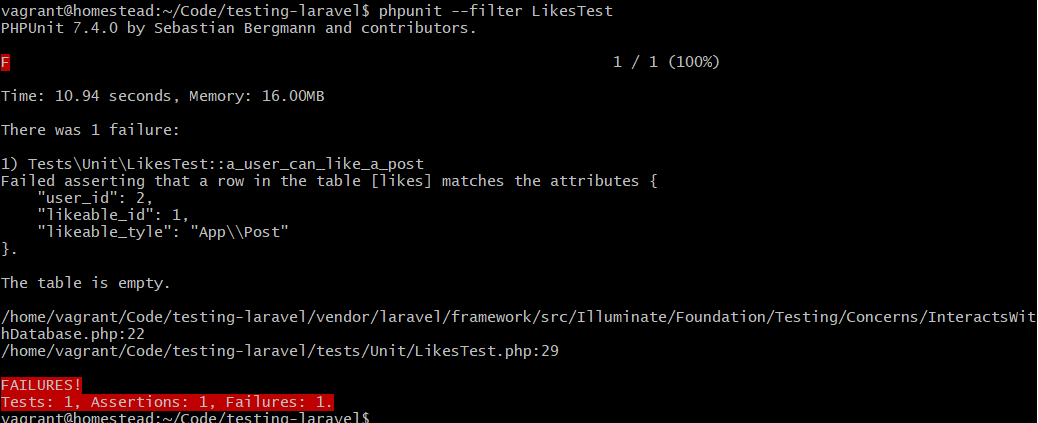
我们没有在数据库存入数据,这就是我们接下来需要做的工作:
app\Post.php
再次测试: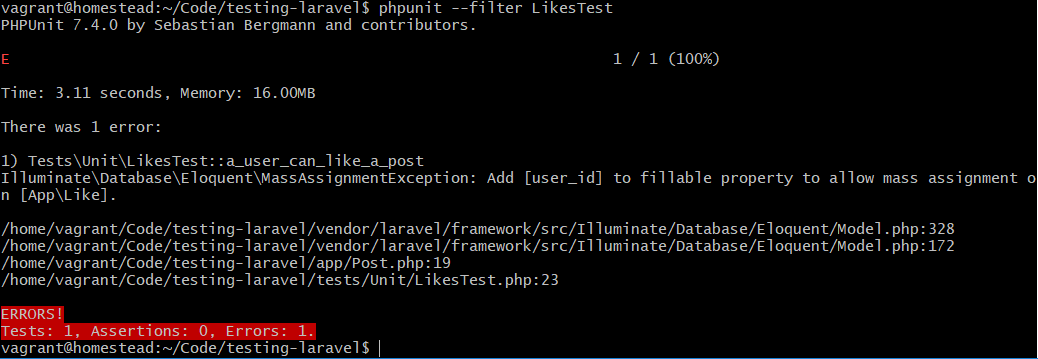
仍旧是批量赋值错误:
app\Like.php
<?php
namespace App;
use Illuminate\Database\Eloquent\Model;
class Like extends Model
{
protected $fillable = ['user_id'];
}再次测试:
我们再来补充一下我们的测试:断言该评论是isLiked。如下:
tests\Unit\LikesTest.php
.
.
/** @test */
public function a_user_can_like_a_post()
{
.
.
$this->assertTrue($post->isLiked());
}
}然后添加isLiked方法:
app\Post.php
.
.
public function isLiked()
{
return $this->likes()
->where(['user_id' => Auth::id()])
->exists();
}
}运行测试:
现在我们已经完成了点赞评论功能的开发,相应地,我们来开发取消点赞功能的开发。我们仍旧从测试开始:
tests\Unit\LikesTest.php
.
.
/** @test */
public function a_user_can_unlike_a_post()
{
$post = factory('App\Post')->create();
$user = factory('App\User')->create();
$this->actingAs($user);
$post->like();
$post->unlike();
$this->assertDatabaseMissing('likes',[
'user_id' => $user->id,
'likeable_id' => $post->id,
'likeable_type' => get_class($post),
]);
$this->assertFalse($post->isLiked());
}
}然后运行测试: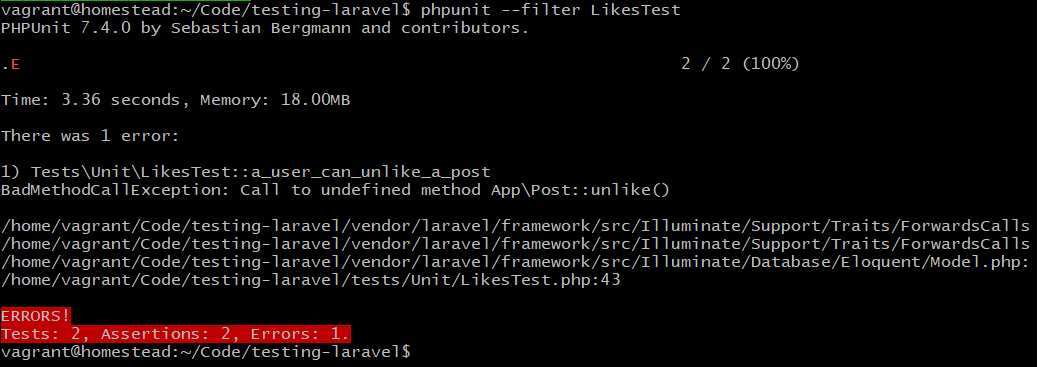
添加unlike方法:
app\Post.php
.
.
public function like()
{
$like = new Like([
'user_id' => Auth::id()
]);
$this->likes()->save($like);
}
public function unlike()
{
$this->likes()
->where(['user_id' => Auth::id()])
->delete();
}
.
.再次测试:
继续前进,我们增加一个新的测试:增加一个toggle方法,当前评论未被点赞时,点赞该话题;已被点赞时,取消点赞该话题。添加测试:
tests\Unit\LikesTest.php
.
.
/** @test */
public function a_user_may_toggle_a_posts_like_status()
{
$post = factory('App\Post')->create();
$user = factory('App\User')->create();
$this->actingAs($user);
$post->toggle();
$this->assertTrue($post->isLiked());
$post->toggle();
$this->assertFalse($post->isLiked());
}
}运行测试:
添加toggle方法:
app\Post.php
.
.
public function toggle()
{
if($this->isLiked()){
return $this->unlike();
}
return $this->like();
}
}再次测试:
接下来我们再添加一个测试:获取点赞该评论的总数。
tests\Unit\LikesTest.php
.
.
/** @test */
public function a_post_knows_how_many_likes_it_has()
{
$post = factory('App\Post')->create();
$user = factory('App\User')->create();
$this->actingAs($user);
$post->toggle();
$this->assertEquals(1,$post->likesCount);
}
}获取likesCount:
app\Post.php
.
.
public function getLikesCountAttribute()
{
return $this->likes()->count();
}
}注:我们使用了 模型访问器 来获取
likesCount
运行测试:
代码开发暂时完成,自然我们就可以来做点重构了。在文章开头说过,点赞一个模型是很常见的功能,并且我们的模型也是应用的是多态关联的。所以我们对点赞的行为的代码是可复用的,我们将其抽取成Trait:
app\Likeability.php
<?php
namespace App;
use Auth;
trait Likeability
{
public function likes()
{
return $this->morphMany(Like::class,'likeable');
}
public function like()
{
$like = new Like([
'user_id' => Auth::id()
]);
$this->likes()->save($like);
}
public function unlike()
{
$this->likes()
->where(['user_id' => Auth::id()])
->delete();
}
public function isLiked()
{
return $this->likes()
->where(['user_id' => Auth::id()])
->exists();
}
public function toggle()
{
if($this->isLiked()){
return $this->unlike();
}
return $this->like();
}
public function getLikesCountAttribute()
{
return $this->likes()->count();
}
}然后我们使用Trait:
app\Post.php
<?php
namespace App;
use Illuminate\Database\Eloquent\Model;
class Post extends Model
{
use Likeability;
}然后再次测试:
重构很成功,但是我们的测试也是可以重构的,我们将在下一节对我们的测试进行些重构。不如你先试试?

 Testing Laravel 单元测试入门笔记
Testing Laravel 单元测试入门笔记




 关于 LearnKu
关于 LearnKu




推荐文章: